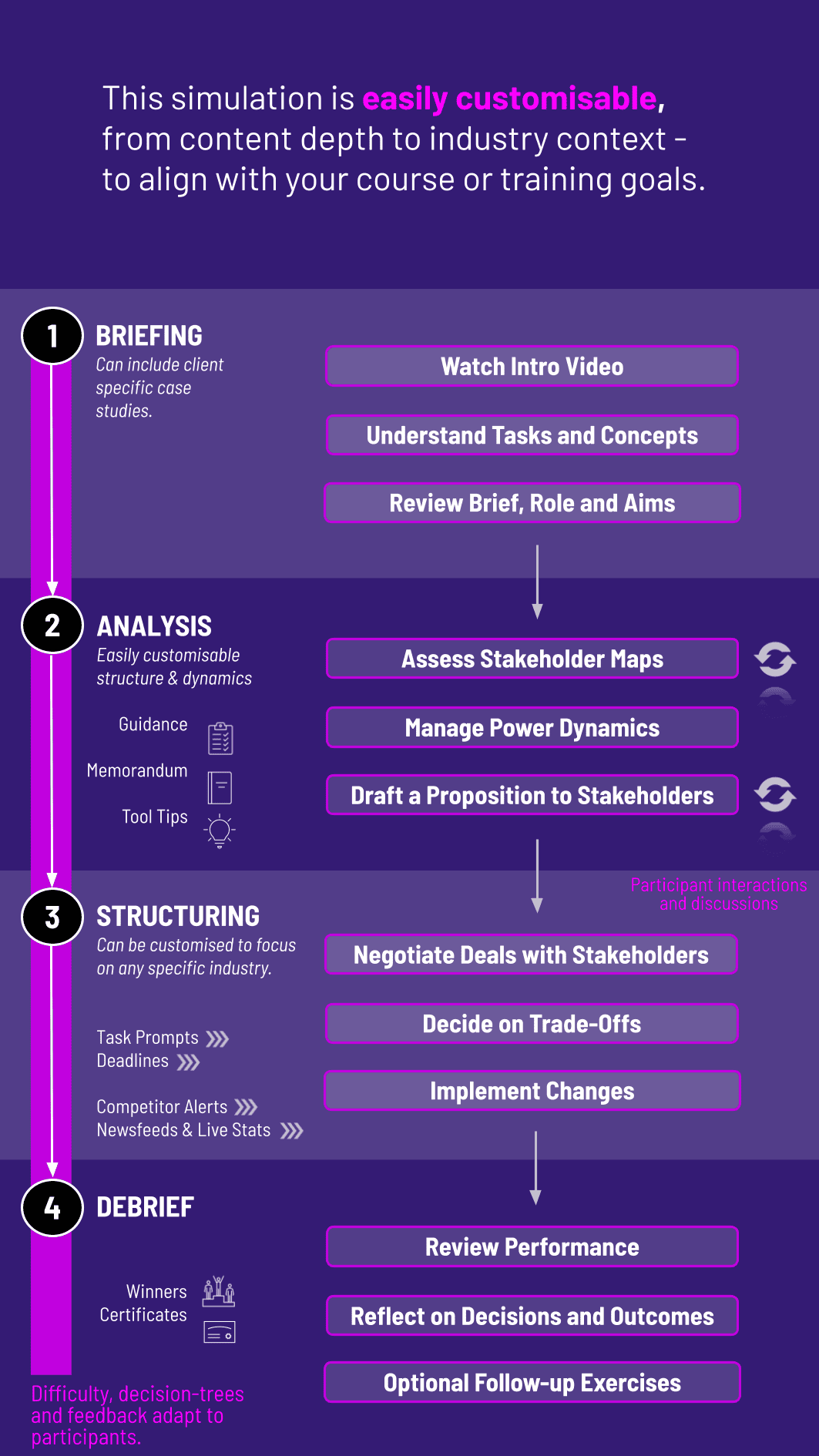
In this Stakeholder Management Simulation, participants act as business leaders balancing internal and external interests - practicing negotiation, alignment, influence, and ethical decision-making in complex, high-pressure stakeholder environments.
Stakeholder Mapping and Power Analysis
Conflict Resolution and Trade-offs
Building Influence Without Authority
Strategic Communication and Narrative Framing
Trust and Credibility in Decision-making
Long-term vs Short-term Stakeholder Value
Cross-functional Alignment
Public Relations and Reputation Risk
Ethical Dilemmas in Stakeholder Strategy


Map and prioritise stakeholders by influence, interest, and urgency
Develop engagement plans and communication strategies
Negotiate internally and externally for alignment
Manage competing goals between shareholders, employees, regulators, and communities
Respond to reputation-sensitive crises or public pressure
Present strategies to peers, instructors, or simulated boards
By the end, participants will be more confident in:
Identifying and managing stakeholder interests under real-world pressure
Communicating clearly with diverse audiences
Making ethical, strategic decisions that consider multiple perspectives
Building influence without formal power
Leading alignment across business units or external parties
Handling reputational risk during contentious decisions
Practicing stakeholder empathy and constructive negotiation
Working collaboratively while balancing individual and team goals
Adapting strategy in response to feedback or political constraints
Developing win-win outcomes in complex environments
The simulation’s flexible structure ensures that these objectives can be calibrated to match the depth, duration, and focus areas of each program, whether in higher education or corporate learning.
This simulation is flexible enough to run in leadership programs, corporate workshops, or university classrooms. It can be played individually or in teams. Here's how it typically unfolds:
1. Receive a Scenario or Brief: Each round starts with a scenario and a challenge - for example, a regulatory backlash, activist investor, or community protest. Participants receive background, objectives, and key context.
2. Analyse the Situation: Participants assess stakeholder maps, communication breakdowns, power dynamics, and operational constraints to decide what matters most and what could escalate.
3. Make Decisions in the Simulation Interface: Participants choose how to engage with stakeholders, what trade-offs to accept, and which priorities to push forward - through structured options or written submissions.
4. Individual or Team Interactions: Depending on the format, participants may role-play negotiations, draft press releases, or align cross-functional teams within a time constraint.
5. Review Results and Reflect: They receive feedback via stakeholder reactions, simulated press coverage, or KPIs like alignment scores or reputational impact - leading to structured debriefs and personal reflection.
6. Repeat the Cycle: Each new round builds complexity or introduces new developments. Participants adapt and apply learning to evolving contexts.
Do participants need prior experience with stakeholder theory? No. The simulation is self-contained and designed for all levels, with built-in explanations and coaching prompts.
Is this simulation suitable for leadership programs? Absolutely. It’s ideal for emerging leaders and senior professionals who deal with cross-functional or public-facing challenges.
Can it be tailored for specific industries? Yes. We can adapt the stakeholder groups and conflict points to reflect sectors like energy, healthcare, banking, or tech.
Is there a strong communication element? Yes. Clear, persuasive communication under pressure is a core component of the gameplay.
Can participants work in teams? Yes. You can assign different stakeholder roles or decision-making responsibilities across teams to mirror real-world dynamics.
How long does the simulation take? It can run as a 2-hour exercise, a half-day workshop, or a full-length module over several weeks.
Can I include it in a university assessment? Yes. With options like written memos, presentations, or peer reviews, it fits easily into academic grading frameworks.
Does it cover ethics? Definitely. Ethical trade-offs are built into several rounds, especially when stakeholder interests clash.
What formats are supported? It can be run fully online, in-person, or in blended formats with guided facilitation.
What roles do participants play? They may act as division heads, comms directors, COOs, or members of cross-functional crisis teams - depending on the setup.
Quality and consistency of stakeholder engagement strategy
Clarity and tone of communication under pressure
Resolution of misalignment or tension
Responsiveness to stakeholder feedback
Peer and self-assessments on collaboration and influence
You can also include memo writing and debrief presentations as part of the assessment structure. Additionally, you can also add a built-in peer and self-assessment tool to see how participants rate themselves. This flexibility allows the simulation to be easily integrated by professors as graded courses at universities and by HR at assessment centres at companies.
Join this 20-minute webinar, followed by a Q&A session, to immerse yourself in the simulation.
or
Book a 15-minute Zoom demo with one of our experts to explore how the simulation can benefit you.